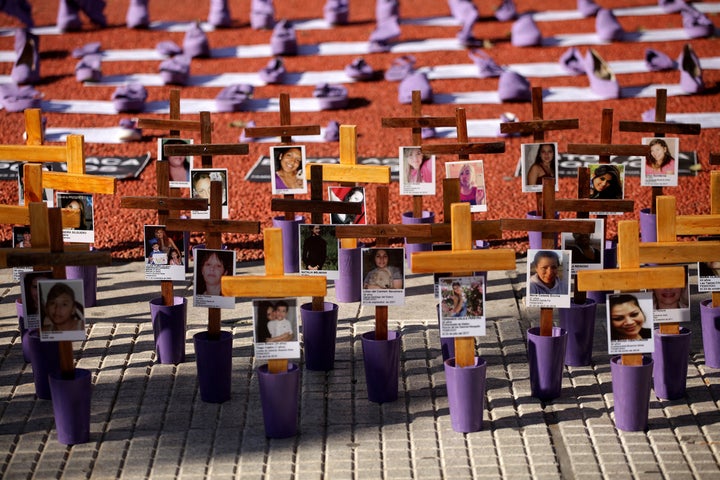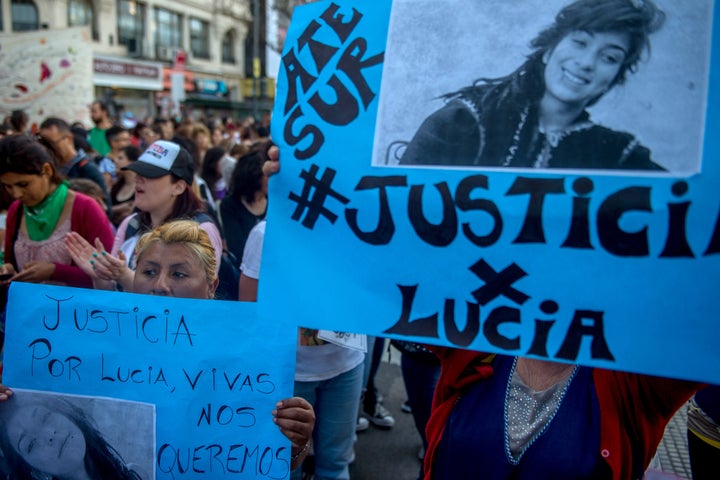
Lucia Perez was 16 when she was killed. At least two men drugged her, raped her and impaled her body in Mar de Plata, Argentina, in 2016. But according to the Argentine courts, her death was a consequence of an overdose of cocaine and weed. Authorities acquitted the perpetrators of sexual assault and femicide and instead sentenced them to eight years in jail for selling drugs.
Her family does not accept the verdict. “It was as if she were killed again,” Marta Montero, Perez’s mother tells HuffPost. “Not only was she killed, she was also blamed her for her death.”
Perez’s death intensified the debate over femicides not just in Argentina, but also in Latin America. After the crime, women from countries across the region, such as Mexico, Uruguay and Guatemala, took to the streets with the “Ni Una Menos” movement, which translates to “Not One Less” and is the name of the protest campaign against gender-based violence. In Argentina, thousands of women marched through the streets in what they called a national strike. In Mar de Plata the march was led by Montero.
According to the United Nations, femicide is understood as the intentional murder of women because they are women. At least 15 countries in Latin America, including Argentina, classify gender-based killings as femicide.
In this region, an average of 12 women die daily because of their gender. According to the U.N., Latin America is home for 14 out of the 25 countries with the highest femicide rates worldwide. And 98% of these crimes targeting women are not labeled as femicides, leading to many cases of impunity.
By treating it as a separate criminal offense, countries can more easily gather data on fatal violence against women. But according to experts interviewed by HuffPost, many Latin American countries are still not accurately tracking femicides. There are wide discrepancies between official state statistics and records of attacks tracked by women’s organizations. Perez is one of those cases.
Six years before Perez’s death, Latin America was already making policy moves to crack down on violence against women. In 2010, Chile added a femicide charge to its criminal code, followed by Guatemala (2010), Costa Rica (2012), Bolivia (2013), El Salvador (2013), Nicaragua (2013) and Argentina (2014). In 2014, Ecuador became the eighth country, passing Article 141 in its criminal code, which defines femicide as the exercise of power relations resulting in the death of a woman for “being a woman.” It punishes the crime with prison sentences ranging from 22 to 26 years.

In the years since, Ecuadorian civil society organizations tracked 711 femicides in the country. But in contrast, the government only registered 348 cases in that same period of time ― less than half.
In 2019, a man set fire to his house. His wife, mother-in-law and sister-in-law were inside, and all three women died. But Ecuador documented only one femicide, because the government concluded that there was not an existing power relation between the perpetrator and the other two victims. Civil society organizations count the three deaths as femicides.
“The [criminal code] establishes that there must exist a power relation between the victim and victimizer,” said Diego Tipan, the undersecretary of Public Safety of Ecuador. “In this particular case there was no power relation between the mother and sister of the victim, and the victimizer; just between the victim and victimizer.” But feminist groups argue that all of the women killed in the incident should be included to accurately represent the toll of femicide, not just the primary target.
Experts told HuffPost that a lack of agreement on what constitutes femicide is one of the main causes for the gaps in the data recorded by officials and those reported by advocacy groups.
Everyday women are being killed in South and Central America due to “machista” violence, says Esther Pineda a Venezuelan sociologist and author of“ Femicide Culture: The Risk of Being a Woman in Latin America.” She calls the murders a silent massacre.
“Making visible the femicide statistics is essential to show society, politicians and media the real magnitude of the problem,” she told HuffPost. In some Latin American countries, she added, data on femicide is manipulated and information is hidden to hide the failures of police and courts.
In 2012, Nicaragua passed Ley 779, the Integral Law Against Violence Against Women, which recognizes femicide as a legal concept. But in 2014, the law was reformed and the definition of femicide changed from homicides stemming from unequal relations of power between men and women to only romantic couple relationships. The reform caused the official figures to be reduced.
Between January and October this year, regional women’s organizations recorded 53 femicides in the Central American country, while the government only documented 18 cases.
Montero believes the femicide of her daughter in Argentina hit a nerve because it exposed a problem that is endemic to the region.
“It’s obvious this (fight) is for Lucia, but she is the flag of the movement. I, as a mother, fight for her but for every woman,” she said.
In Perez’s case, Argentine authorities said her death was not a femicide because the teenager had previously had a consensual sexual relationship with one of the men who assaulted her and because she had consumed drugs.
“I never think bad or ugly things of the suffering she would have gone through. I see her differently, I see her pretty, with the beautiful smile she had. [She was a] good daughter, companion, because Lucia was noble at heart,” Montero said.

State Of Emergency
Many feminist groups have called for a declaration of a state of emergency in their countries to address violence against women as Puerto Rico did last September.
Pineda explains this is a way of recognizing the gravity of these offenses. A state of emergency in this matter should guarantee: prevention of violence against women, attention and protection to the victims, and the investigation of femicide cases and prosecution of the perpetrators.
“In Latin America this emergency should be declared immediately on the countries with the highest rates of femicides, including Mexico, El Salvador, Guatemala, the Dominican Republic, Colombia, Peru and Argentina,” Pineda said.
In Ecuador, feminist movements have demanded the declaration of emergency several times. The last protests against femicide were in June of 2019, after the murder of Evelyn Caroline Bravo Bodero, who was volunteer of Cepam, an organization that fights violence against women. But, relying on the official statistics, the government says the numbers don’t justify a declaration of a state of emergency.
In Puerto Rico, Gov. Wanda Vasquez declared a national state of alert over violence against women after researchers investigating Hurricane Maria found irregularities in the official data on violence against women. As the former head of the island’s Office for Women’s Rights, Vasquez has a long career as an advocate for survivors of domestic abuse. But she was also accused of cutting funds to women’s rights organizations during her time in that role.
If perpetrators of femicide are not penalized, it gives them a “license to kill,” Pineda says.
Montero, Lucia’s mother, agreed.
“We need to insist these femicides are crimes against humanity,” she said.
This article was reported in partnership with the International Center for Journalists.